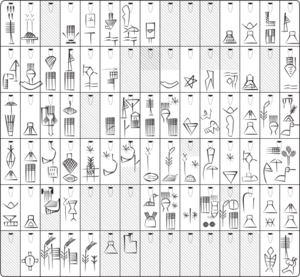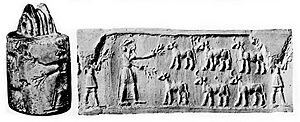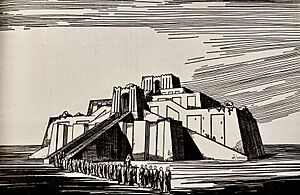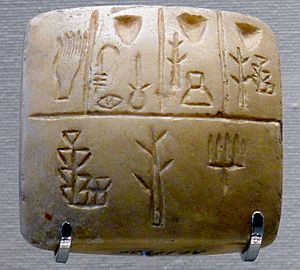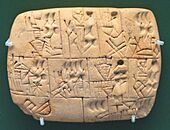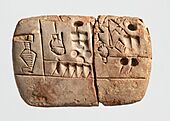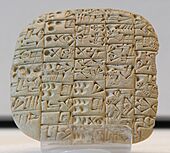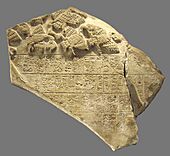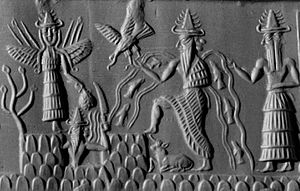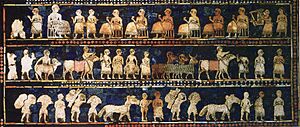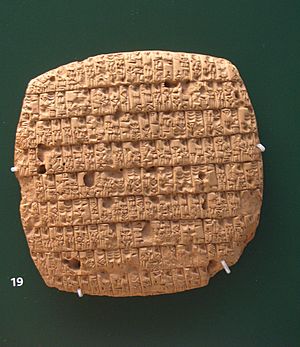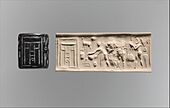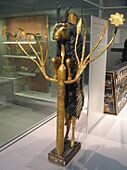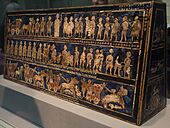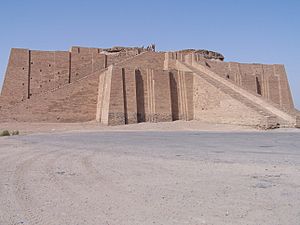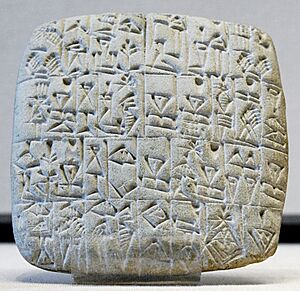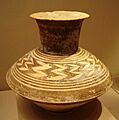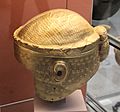Sumer facts for kids
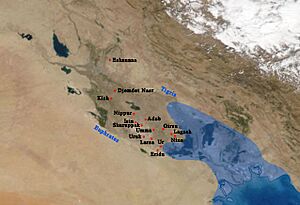
The general location on a modern map, and main cities of Sumer with ancient coastline. The coastline nearly reached Ur in ancient times.
|
|
| Religion | Sumerian religion |
|---|---|
| Language | Sumerian |
| Geographical range | Mesopotamia, Near East, Middle East |
| Period | Late Neolithic, Middle Bronze Age |
| Dates | c. 5500 – c. 1800 BC |
| Preceded by | Ubaid period |
| Followed by | Akkadian Empire |
Sumer was one of the very first great civilizations in history. It was located in a region called Mesopotamia, which is now part of south-central Iraq. This amazing civilization began around 5500 to 4500 BC, during the Stone Age and early Bronze Age. Sumer is considered one of the "cradles of civilization," like ancient Egypt and the Indus Valley Civilisation.
The Sumerian people lived near the Tigris and Euphrates rivers. These rivers helped their farmers grow lots of grain and other crops. Having extra food allowed them to build large towns and cities. The oldest known writings in the world come from Sumerian cities like Uruk and Jemdet Nasr. These writings date back to about 3350 to 2500 BC.
Contents
- What's in a Name? Understanding Sumer's Identity
- Where Did the Sumerians Come From?
- Uncovering Ancient Sumer: Archaeological Discoveries
- Sumerian City-States: Early Urban Centers
- A Timeline of Sumerian History
- Population of Sumer
- Sumerian Culture and Daily Life
- Social Life and Family
- Language and Writing: The Birth of Cuneiform
- Sumerian Religion and Beliefs
- Agriculture and Farming Life
- Sumerian Art and Craftsmanship
- Sumerian Architecture and Buildings
- Mathematics and Numbers
- Economy and Trade Networks
- Sumerian Military and Warfare
- Sumerian Technology and Inventions
- The Lasting Legacy of Sumer
- Images for kids
- See also
What's in a Name? Understanding Sumer's Identity
The name "Sumer" comes from the Akkadian people. They were a group who later lived in Mesopotamia and called the original inhabitants "Sumerians." The Sumerians themselves had a different name for their land. They called it "Kengir," which meant "Country of the noble lords." Their language was known as "Emegir."
Where Did the Sumerians Come From?
Most historians believe that the first people to settle in Sumer permanently arrived between 5500 and 3300 BC. They were from West Asia and spoke the Sumerian language. This language is unique and not related to many other languages we know today.
Before the Sumerians, another group of people called the "Ubaidians" lived in the region. Modern scholars think the Ubaidians were the first to bring civilization to Sumer. They learned to drain marshlands for agriculture, developed trade, and started industries like weaving and pottery.
The Sumerian civilization really began to grow during the Uruk period (around 4000-3100 BC). The city of Eridu, located near the Persian Gulf, is thought to be one of the oldest cities. Here, different groups of people came together: farmers who used irrigation, nomadic herders, and fisher folk.
Over time, the Sumerians began to lose control to other groups, especially the Semitic-speaking people from the northwest. The Akkadian Empire conquered Sumer around 2270 BC. Even after this, the Sumerian language continued to be used for religious purposes. Later, Sumerian rule returned for about 100 years during the Third Dynasty of Ur, from about 2100 to 2000 BC.
Uncovering Ancient Sumer: Archaeological Discoveries
For a long time, no one knew about the Sumerians. The word "Sumer" was first used by a scholar named Jules Oppert in 1869. The first major digs of Sumerian cities happened in the late 1800s and early 1900s. French archaeologist Ernest de Sarzec excavated Girsu in 1877. Later, John Punnett Peters worked at Nippur, and Robert Koldewey explored Shuruppak. These discoveries helped us learn a lot about this ancient civilization.
Sumerian City-States: Early Urban Centers
In the late 4th millennium BC, Sumer was made up of many independent city-states. These cities were separated by canals and boundary markers. Each city had a main temple dedicated to its special god or goddess. A priestly governor or a king, who was closely connected to the city's religious practices, ruled each city.
Some of the important Sumerian cities included:
These cities were mostly located in the fertile plain between the Euphrates and Tigris rivers, in what is now southern Iraq.
A Timeline of Sumerian History
The Sumerian city-states grew powerful during the prehistoric Ubaid and Uruk periods. We have written records from as far back as the 27th century BC. However, these early writings are sometimes hard to understand. They become clearer around the 23rd century BC, helping archaeologists learn more about this time.
The Akkadian Empire was the first state to unite large parts of Mesopotamia in the 23rd century BC. After a period of rule by the Gutians, the Third Dynasty of Ur also united parts of Mesopotamia. This kingdom ended around 2000 BC due to invasions by the Amorites. Later, Mesopotamia was united under Babylonian rule around 1700 BC.
The Ubaid Period (around 6500–4100 BC)
This period is known for its special style of beautifully painted pottery. This pottery was found all over Mesopotamia and the Persian Gulf. The Ubaid culture likely came from the Samarran culture in northern Mesopotamia. It's unclear if these were the first Sumerians, but they laid the groundwork for later developments.
The Uruk Period (around 4100–3100 BC)
During the Uruk period, pottery changed from being handmade to being mass-produced on fast wheels. Trade grew along the rivers and canals, leading to the rise of large, organized cities. These cities had populations of over 10,000 people and were managed by central administrations. People who worked for others, sometimes captured from nearby regions, were used as laborers.
Sumerian cities during this time were probably led by a priest-king, advised by a council of elders. There wasn't much evidence of organized warfare, and towns usually didn't have walls. Uruk became the largest city in the world, with more than 50,000 people.
The Early Dynastic Period (around 2900–2334 BC)
This period saw a shift from religious leaders to more secular kings, known as Lugal. Famous legendary figures like Gilgamesh are from this time. The center of Sumerian culture remained in southern Mesopotamia. Cities became walled and grew larger as smaller villages disappeared. This suggests there was more warfare during this period.
Lagash's First Dynasty (around 2500–2270 BC)
The dynasty of Lagash, though not on all king lists, is well-known from many archaeological finds. Eannatum of Lagash created one of the first known empires. He took control of almost all of Sumer and parts of Elam. His famous Stele of the Vultures shows his army's victory over enemies. His empire, however, did not last long after his death.
The Akkadian Empire (around 2334–2154 BC)
The Akkadian Empire was founded by Sargon of Akkad. The Akkadian language, which is a Semitic language, became very important. Although Sumerian was still used for official documents, Akkadian was widely spoken. These two languages were used side-by-side for about a thousand years. By 1800 BC, Sumerian became mostly a language for scholars and religious texts.
The Gutian Period (around 2193–2119 BC)
The Gutian people, from the Zagros Mountains, took control after the Akkadian Empire weakened. This time is sometimes called a "dark age" because we have less information about it. The Gutian period ended when Utu-hengal of Uruk defeated the last Gutian king. Soon after, Ur-Nammu of Ur established the Third Dynasty of Ur.
The Ur III Period (around 2119–2004 BC)
The Third Dynasty of Ur, led by kings like Ur-Nammu and Shulgi, brought a period of renewed Sumerian influence. However, the region was already becoming more Semitic, with Akkadian speakers and Amorite groups growing in power. Sumerian continued to be used in schools and for religious purposes, much like Latin was used in medieval Europe.
The Decline of Sumerian Power
Over time, the agricultural land in southern Mesopotamia became less productive due to increasing salt in the soil. This problem, caused by irrigation in a dry climate, reduced crop yields. As a result, the population in this area decreased significantly between 2100 BC and 1700 BC. This weakened the Sumerian-speaking regions and strengthened the Akkadian-speaking areas. Sumerian then became mainly a language for literature and religious ceremonies.
After an invasion by the Elamites, Sumer came under Amorite rule. This period ended with the rise of Babylonia under Hammurabi around 1800 BC.
Population of Sumer
At its peak, Uruk, one of Sumer's largest cities, may have had 50,000 to 80,000 people. Considering other cities and the farming population, Sumer's total population might have been between 0.8 million and 1.5 million people. The world population at that time was estimated to be around 27 million.
The Sumerians spoke a unique language. Some archaeologists believe the first Sumerian speakers were farmers who moved south from northern Mesopotamia after developing irrigation techniques. These farmers were able to thrive in the challenging environment by organizing their labor and technology for water control.
Sumerian Culture and Daily Life
Social Life and Family
Early Sumerian records show that pottery was very common, with many types of vases and dishes. They had special jars for honey, butter, oil, and wine. People wore feathered head-dresses and used beds, stools, and chairs with carved legs. Tools like knives, drills, and saws were known. Spears, bows, arrows, and daggers were used in warfare.
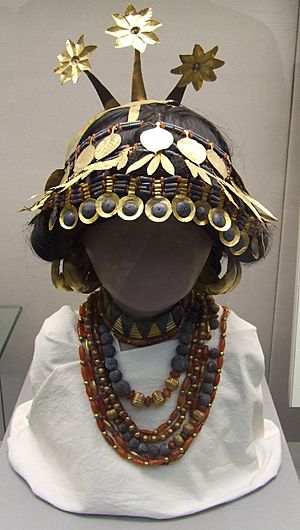
Sumerian society was generally led by men and had different social levels. Below the king, people were either free citizens or workers who served others. Women in early Sumer played important public roles, sometimes as priestesses. They could own property and had their rights protected. Sons and daughters inherited property equally. However, the status of women changed over time, and their rights became more limited after 2300 BC.
Marriages were usually arranged by the parents of the bride and groom. Engagements were made official with contracts written on clay tablets. A marriage became legal when the groom gave a gift to the bride's father.
Language and Writing: The Birth of Cuneiform
One of the most important Sumerian inventions was cuneiform script, a system of writing. Archaeologists have found hundreds of thousands of clay tablets written in Sumerian cuneiform. These tablets contain personal letters, business records, laws, hymns, prayers, stories, and daily accounts.
The writing system started with pictures (hieroglyphs) but quickly developed into wedge-shaped marks made with reeds on wet clay. Many texts survived because scribes in training copied them repeatedly. Sumerian remained the language of religion and law in Mesopotamia long after other languages became more common.
A famous example of cuneiform writing is the Epic of Gilgamesh. This long poem tells the fictional adventures of King Gilgamesh and his friend Enkidu. It is considered one of the earliest known works of fictional literature.
The Sumerian language is unique and not related to any other known language family. Akkadian gradually replaced Sumerian as a spoken language around 2000 BC. However, Sumerian continued to be used for religious, literary, and scientific purposes until about the 1st century AD.
Sumerian Religion and Beliefs
The Sumerians believed in many gods and goddesses who looked and acted like humans. Each city-state had its own special gods, temples, and priest-kings. However, gods from one city were often recognized in others. The Sumerians were among the first to write down their religious beliefs, which greatly influenced later Mesopotamian myths and religions.
Some of the main Sumerian gods included:
- An: The god of the sky.
- Enki: The god of wisdom and fresh water, believed to have given humans arts and sciences.
- Enlil: The god of storm, wind, and rain, and the chief god of the Sumerian pantheon.
- Inanna: The goddess of love and war, often linked to the planet Venus.
- Utu: The sun-god.
- Sin: The moon god.
Sumerians believed their gods created humans from clay to serve them. Temples organized large projects, like irrigation, and citizens had a duty to work for the temple.
Sumerian Cosmology and the Afterlife
Sumerians imagined the Earth as a rectangular field with four corners. They believed that after death, people would go to a gloomy underworld. The universe was divided into four main regions:
- To the north were the Subartu, who lived in the hills.
- To the west were the Martu, nomadic people who herded sheep and goats.
- To the south was Dilmun, a trading state linked to the land of the dead.
- To the east were the Elamites, a rival people.
Their known world stretched from the Mediterranean Sea to the Persian Gulf, and included lands like Meluhha (likely the Indus Valley) and Magan (Oman), known for copper.
Temples and Ziggurats
Sumerian temples, called Ziggurats, each had a unique name. They featured a courtyard with a central pond for purification. The main temple building had a central hall with rooms for priests on the sides. At one end, there was a platform and a mudbrick table for offerings. Storage buildings were usually near the temples. Over time, Sumerians began building temples on top of rising, multi-layered platforms, creating the famous ziggurat style.
Funerary Practices
The Sumerians believed that when people died, they would go to a gloomy underworld. The dead were buried outside the city walls in graveyards. Small mounds covered the bodies, along with offerings and some food.
Agriculture and Farming Life
The Sumerians adopted farming around 5000–4500 BC. They developed advanced agricultural methods, including organized irrigation and large-scale farming. They grew many crops and used plows, with specialized workers managing the fields. The need to keep track of temple accounts for these large farms led to the development of writing around 3500 BC.
Early Sumerian records show that sheep, goats, cattle, and pigs were domesticated. They used oxen for heavy work and donkeys for transport. Wool from animals was used for clothing and rugs. Farmers grew wheat, barley, chickpeas, lentils, dates, onions, garlic, and lettuce. They also caught fish and hunted birds and gazelles.
Sumerians were among the first known societies to drink beer. Cereals were abundant and were the main ingredient in their early brews. Beer brewing was very important and even mentioned in the Epic of Gilgamesh.
Sumerian agriculture relied heavily on irrigation using canals, dikes, and reservoirs. The Tigris and Euphrates rivers often flooded, so canals needed constant repair and cleaning. The government required people to work on these canals. Farmers would flood their fields, then drain the water, and use oxen to stomp out weeds. They would then plow and prepare the soil before planting seeds. Due to high evaporation, salt gradually built up in the fields. By the Ur III period, farmers switched from wheat to barley, which was more tolerant to salt.
Sumerian Art and Craftsmanship
The Sumerians were skilled artists. Their artifacts show great detail and decoration, often using precious materials like lapis lazuli, marble, gold, and silver. Since stone was rare, it was mainly used for sculptures. Clay was the most common material for many Sumerian objects. Small precious stones were used for cylinder seals.
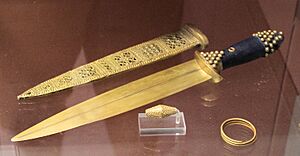
Some of the most famous artworks are the Lyres of Ur, which are considered the world's oldest surviving stringed instruments. These were found during excavations of the Royal Cemetery at Ur between 1922 and 1934.
Sumerian Architecture and Buildings
The Tigris-Euphrates plain had few minerals and trees. Sumerian buildings were mostly made of mudbricks, without mortar. Mudbrick buildings would eventually wear down, so they were regularly torn down and rebuilt on the same spot. This constant rebuilding created raised mounds, called "tells," which are found across the ancient Near East.
Early Sumerian pictures suggest that stone was scarce but used for blocks and seals. Brick was the main building material for cities, forts, temples, and houses. Cities had towers and were built on raised platforms. Houses also looked like towers and had doors that could be opened with a key.
The most impressive Sumerian buildings were the ziggurats, which were large, layered platforms that supported temples. Sumerians also developed the arch, which allowed them to build strong domes. Their temples and palaces used advanced techniques like buttresses and half columns.
Mathematics and Numbers
The Sumerians developed a complex system of measurement around 4000 BC. This led to advances in arithmetic, geometry, and algebra. From about 2600 BC, Sumerians wrote multiplication tables on clay tablets and solved geometry and division problems. They were among the first to use a place value number system. They also used an abacus and a base-60 number system, which became standard in Sumer and Babylonia. They were the first to figure out the area of a triangle and the volume of a cube.
Economy and Trade Networks
Archaeological finds show that Sumer had a wide-ranging trade network. They imported obsidian from Anatolia, lapis lazuli from Afghanistan, and beads from Dilmun (modern Bahrain). Seals with Indus Valley script suggest trade with that distant civilization. Metals of all types had to be imported.
The Epic of Gilgamesh mentions trade with faraway lands for goods like wood, which was rare in Mesopotamia. Cedar wood from Lebanon was highly valued. The discovery of resin in the tomb of Queen Puabi at Ur shows trade from as far away as Mozambique.
Some people worked for others, for example, as weavers, pressers, or porters. Sumerian potters decorated pots with cedar oil paints. Masons and jewelers used materials like alabaster, ivory, iron, gold, silver, and carnelian.
Trade with the Indus Valley
Evidence of trade between the Indus Valley and Ur dates back to around 2350 BC. Objects made from shells found on the Indus coast have been discovered in Mesopotamia. Carnelian beads from the Indus, with special etched designs, were found in the Sumerian tombs of Ur. Lapis lazuli, likely from Afghanistan, was also traded across the Iranian plateau to Mesopotamia and Egypt.
Several Indus seals with Harappan writing have been found in Mesopotamian cities like Ur, Babylon, and Kish. Rulers like Gudea of Lagash imported "translucent carnelian" from Meluhha, which is generally thought to be the Indus Valley area.
Money and Credit in Sumer
Large institutions kept their accounts using barley and silver, often with a set exchange rate between them. Debts, loans, and prices were usually listed in one of these. Many transactions involved debt, such as goods given to merchants by temples.
Commercial loans, often for trade expeditions, were usually in silver. The interest rate was set at 1/60 a month (one shekel per mina) before 2000 BC and stayed that way for about two thousand years. Rural loans, often due to unpaid debts to institutions, were in barley or other crops and had much higher interest rates.
Sumerian Military and Warfare
The frequent wars between Sumerian city-states over 2000 years helped develop their military technology. The first detailed war record is between Lagash and Umma around 2450 BC, shown on the Stele of the Vultures. It depicts the king of Lagash leading a Sumerian army of infantry soldiers. These soldiers carried spears, wore copper helmets, and used rectangular shields. They fought in formations similar to a phalanx, suggesting they had professional soldiers.
The Sumerian military used carts pulled by onagers (wild donkeys). These early chariots were used for transport, and their crews carried battle-axes and lances. Sumerian cities were protected by strong walls. They engaged in siege warfare, but the mudbrick walls could often defend against attackers.
Sumerian Technology and Inventions
The Sumerians were very inventive. Some of their key technologies include:
- The wheel: First used as a potter's wheel, then for vehicles.
- Cuneiform script: Their writing system.
- Arithmetic and geometry: Advanced mathematical knowledge.
- Irrigation systems: Canals, dikes, and reservoirs for farming.
- Boats: Different types for transport and trade.
- Lunisolar calendar: A calendar based on both the moon and the sun.
- Bronze: An important metal alloy.
- Tools: Saws, chisels, hammers, axes, knives, daggers, harpoons.
- Military gear: Helmets, shields, spears, arrows, swords, chariots, armor.
- Other items: Leather goods, pins, rings, boots, sandals, and beer.
The Lasting Legacy of Sumer
The Sumerians left a huge mark on history.
- They developed wheeled vehicles, which appeared around the same time in Mesopotamia, the Northern Caucasus, and Central Europe.
- Their cuneiform script is one of the oldest deciphered writing systems.
- They were early astronomers, mapping stars into constellations, many of which are still recognized today. They also knew about the five planets visible to the naked eye.
- They invented and developed arithmetic, using a base-60 number system that became standard in Mesopotamia.
- They may have created early military formations and divided armies into infantry, cavalry, and archers.
- They developed the first known legal and administrative systems, with courts, jails, and government records.
- The first true city-states arose in Sumer.
- Writing expanded beyond simple records to include messages, history, legends, and mathematics.
- The first formal schools were established, often linked to city temples.
Images for kids
-
A fragment of Eannatum's Stele of the Vultures.
-
Portrait of a Sumerian prisoner on a victory stele of Sargon of Akkad, c. 2300 BC.
-
Sumerian prisoners on a victory stele of the Akkadian king Sargon, c. 2300 BC.
-
Silver model of a boat, from the Royal Cemetery of Ur, 2600–2500 BC.
See also
 In Spanish: Sumeria para niños
In Spanish: Sumeria para niños
- Numeral system
- Ancient Mesopotamian units of measurement
- Ancient Mesopotamian religion
- Indus–Mesopotamia relations
- Egypt–Mesopotamia relations
- History of institutions in Mesopotamia



